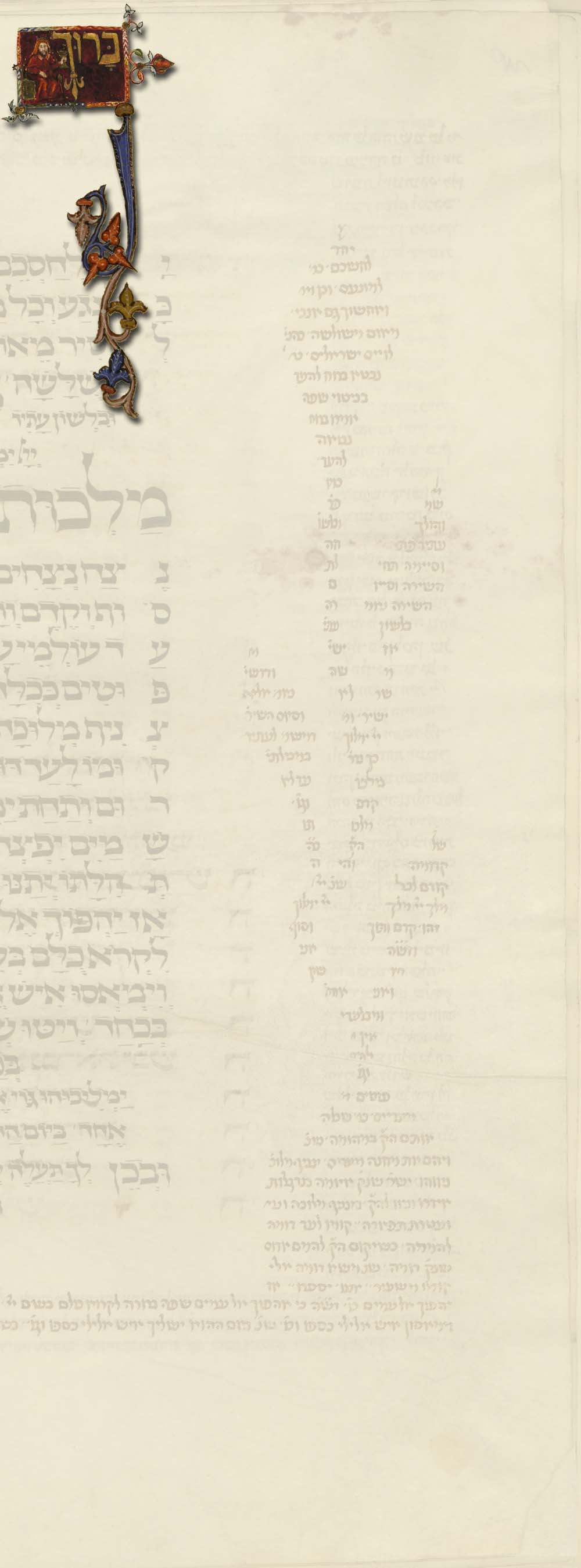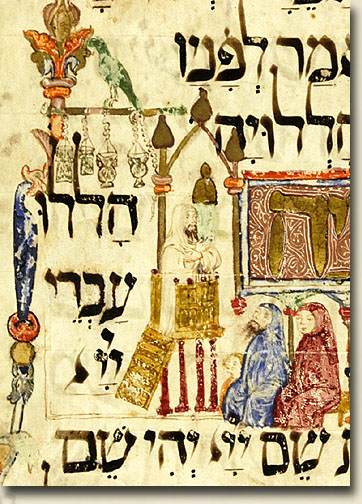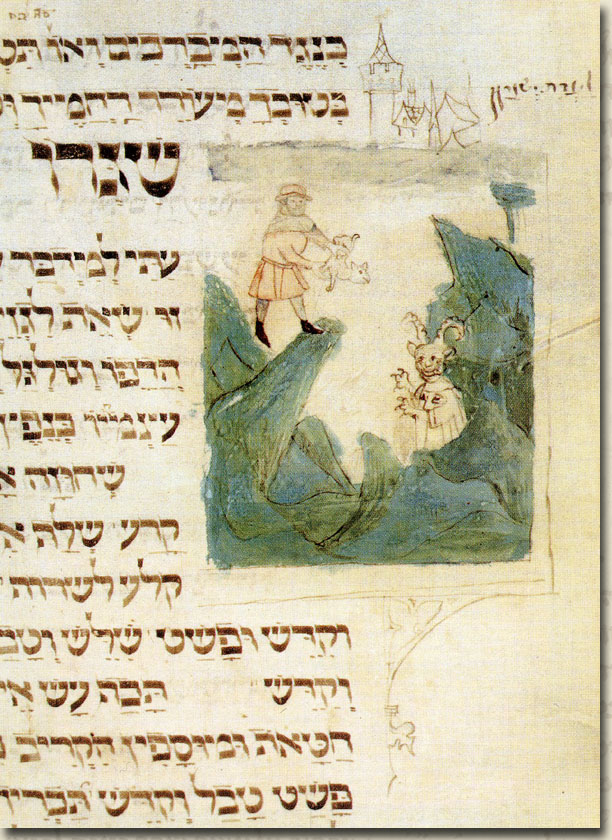




The lamps that appear in the fine panel, depicting the interior of a synagogue in the text, are indicative of a certain Middle Eastern connection (fol. 42r). This panel illustrates the morning prayer, which forms part of the Pesach ritual. 205 (This practice – no longer followed – consisted of reciting the haggadah in the synagogue for the benefit of those who were unskilled in reciting it.) 206 These lamps must have been quite widespread in contemporary Catalonia because they appear not only in other places of our manuscript (fols 1v; 6r) but in other Haggadahs of Catalonian origin too. 207 In connection with these lamps it may be noted that they are characteristic of Cairene mosques of the Mamluk period – the best known among them are perhaps the splendid specimens decorating the Mosque of Sultan Hasan.
One must note that, in Egypt, the mosques at night were lit by lamps of glass or bronze. The former, at the best period, were of polychrome enamelled glass made in Syria. The art of making such lamps appears to have developed about A. D. 1250 and to have died out at the very beginning of the fifteenth century, probably owing to the disaster of 1401, when Damascus was captured by Timur, or Tamerlane, who led its architects and craftsmen away captive to embellish his capital Samarkand. Only about a hundred and fifty of these enamelled glass lamps have survived and about three quarters of them are in the possession of the Museum of Arab Art [=Museum of Islamic Art in Cairo today]. 208
In the Mahzor produced in Germany, perhaps in Heilbronn, between 1370 and 1400 (MS Kaufmann A 387), in connection with one of the prayers of the Day of Atonement the artist depicted the scene when the male figure, coming from the sanctuary in accordance with Leviticus 16:22 and traditional imagination, casts the scapegoat from the cliff into the abyss, to Azazel, who appears in our illustration as a horned and clawed mountain demon or devil. 209

 205 For a detailed description of
the scene see Sed-Rajna:
The Kaufmann Haggadah. Budapest 1990. 13. Cf. also
Müller – von Schlosser:
Bilderhaggaden 1898. 197 [ad p. 72]. Narkiss
– Sed-Rajna 1988. Kaufmann Haggadah. Card No. 43.
205 For a detailed description of
the scene see Sed-Rajna:
The Kaufmann Haggadah. Budapest 1990. 13. Cf. also
Müller – von Schlosser:
Bilderhaggaden 1898. 197 [ad p. 72]. Narkiss
– Sed-Rajna 1988. Kaufmann Haggadah. Card No. 43.
206 Joseph
Gutmann: The illuminated
medieval Passover haggadah: investigations and research problems. In:
Studies in Bibliography and Booklore 7 (1965) 18 [of the
offprint].
207 Similar lamps can be seen in the
Sarajevo Haggadah, in the Haggadahs of the British Library shelf-marks
Or. 2737 (fol. 20v) and 2884 (fol. 17v) – all three Haggadahs are of
Spanish origin. Eugen Werber:
The Sarajevo Haggadah. Sarajevo 1988. fol. 34r [plates],
fol. 31v [text]. Narkiss 1982. II. 21 [Fig. 81].
Müller
– von Schlosser: Die
Haggadah 1898. 321.
Ibid. Tafelband.
Fol. 34. Müller –
von Schlosser: Bilderhaggaden 1898. 104-105 [fol.
17v], Tafel VI, Fig. 1. In the latter place we can see the interior of a
synagogue wholly reminiscent of ours (MS Brit. Mus. Or. 2884, fol. 17v).
G. Margoliouth's
description, according to which it shows “the head of the family in a
sort of «Mimbar», or pulpit” is probably false although the Hebrew
caption says so itself. Müller
– von Schlosser:
Bilderhaggaden 1898. 110.
Munkácsi's effort at solving this riddle remains unsuccessful.
Ernest [=Ernő] Munkácsi:
Ancient and medieval synagogues in representations of the fine arts.
In: Jubilee volume in honour of Prof. Bernhard Heller on the occasion
of his seventieth birthday. Ed. by Alexander Scheiber. Budapest
1941. 246-247. Vid. also Narkiss 1982. I 75 [ad fol. 17v], II. 59 [fig.
187]. A similar interior can also be seen in the
Catalonian Haggadah Add. 14761 in the British Library. Ibid. I. 83 [fol.
65v], II. 78 [fig. 241]. Cf.
Gutmann 1965. 18 [of
the offprint.
208 Keppel Archibald Cameron
Creswell: Architectural
note. In: Count Patrice
de
Zogheb: Our home in
Cairo. With an architectural note by Professor K. A. C.
Creswell. Alexandria [1941]
27-28. On the enamelled glass lamps see Max
Herz: Le Musée National
du Caire. In: Gazette des Beaux-Arts. Ser. 3, v. 28 (1902) 497-505.
Id.: [Gouvernement
Égyptien. Comité de conservation des monuments de l'art arabe.]
Catalogue raisonné des monuments exposés dans le Musée National de l'Art
Arabe précédé d'un aperçu de l'histoire de l'architecture et des arts
industriels en Égypte. Deuxième édition. Cairo 1906. 297-338.
Id.: [Egyptian
Government. Commission for the Preservation of Monuments of Arab Art.].
A descriptive catalogue of the objects exhibited in the National Museum
of Arab Art preceded by a historical sketch of the architecture and
industrial arts of the Arabs in Egypt. Second edition. Transl. by G.
Foster
Smith. Cairo 1907. 275-312.
According to Diez the
technique of the production of enamelled glass lamps passed from Iraq to
Syria, then to Egypt and from there to Venice. Ernst
Diez: Die Kunst der
islamischen Völker. [2nd edition?] Wildpark-Potsdam [no date (after
1926)]. 191. Esin Atil:
Renaissance of Islam. Art of the Mamluks. Washington, D.C. 1981.
118-124, esp. 120-121. These lamps – like other Mamluk glass products –
were imitated in Europe at the end of the 19th century. Ibid. 123. A
shabbat-lamp of this type originating from Damascus, with Hebrew
inscription, is preserved in the Jewish Museum in London.
Sed-Rajna 1976. 126.
(According to the caption the lamp is made of glass but it seems rather
to be made of silver.)
209
Kaufmann 1898. 270. Narkiss
– Sed-Rajna 1988. The Heilbronn Mahzor. Card No. 25. On Azazel
see Encyclopaedia Judaica. Jerusalem – New York 1971-1972. III.
999-1000. Bibel-Lexikon 1981. 155-156 (s.v. Azazel).
